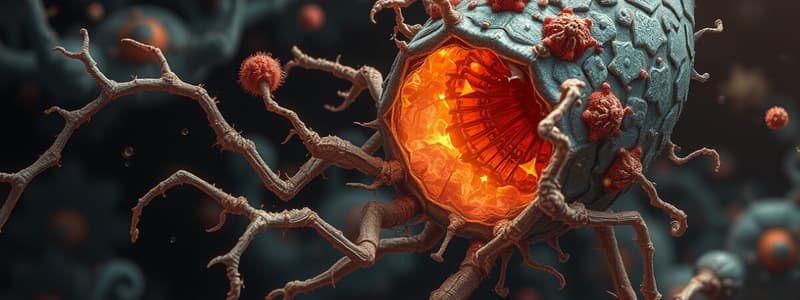Podcast
Questions and Answers
What is programmed cell death?
What is programmed cell death?
- A normal physiological form of cell death (correct)
- Death caused by toxins
- An accidental form of cell death
- A rapid form of cell death
Why is apoptosis important for development?
Why is apoptosis important for development?
To eliminate unwanted tissues or cells.
How does apoptosis help in adults?
How does apoptosis help in adults?
Maintains constant cell number.
What role does apoptosis play in disease states?
What role does apoptosis play in disease states?
What is necrosis?
What is necrosis?
Which of the following is a characteristic of apoptosis?
Which of the following is a characteristic of apoptosis?
What is the outcome of DNA damage in apoptosis?
What is the outcome of DNA damage in apoptosis?
The main components involved in mitochondrial apoptosis are ______ and ______.
The main components involved in mitochondrial apoptosis are ______ and ______.
Which of the following proteins is responsible for the activation of Ced-3?
Which of the following proteins is responsible for the activation of Ced-3?
Ced-9 is a pro-apoptosis protein.
Ced-9 is a pro-apoptosis protein.
What are the two pathways of apoptosis?
What are the two pathways of apoptosis?
What happens when FAS ligand binds to its receptor?
What happens when FAS ligand binds to its receptor?
In apoptosis, chromatin undergoes _____ and nuclear material is destroyed.
In apoptosis, chromatin undergoes _____ and nuclear material is destroyed.
Match the following genes with their role:
Match the following genes with their role:
What is the result of activated caspases?
What is the result of activated caspases?
What happens to a cell during apoptosis?
What happens to a cell during apoptosis?
Flashcards are hidden until you start studying
Study Notes
Programmed Cell Death
- Programmed cell death (apoptosis) is a physiological process essential for tissue maintenance and development in both adults and embryos.
- Characterized as an energy-dependent and active process with distinct morphological changes.
Importance of Apoptosis
- Development: Crucial for eliminating unnecessary tissues and cells during organismal growth.
- Adults: Maintains a constant number of cells, regulating the turnover of old or damaged cells.
- Disease States: Removes damaged or dangerous cells, such as those infected by viruses, helping to prevent disease progression.
Developmental Examples
- Notable in the formation of the nervous system, where apoptosis shapes the neural network by eliminating excess neurons.
Adult Cell Regulation
- In adults, apoptosis is vital for maintaining the epithelial cells lining the gastrointestinal tract, allowing for continuous regeneration and turnover.
Role in Disease States
- In cancer, apoptosis aids in eliminating infected or malignant cells, curtailing tumor growth by triggering cell death.
Necrosis vs. Apoptosis
- Necrosis is always pathological and results from injury, leading to cell membrane damage and inflammation.
- Symptoms include cell swelling and leakage of intracellular components, affecting multiple cells rather than inducing programmed cell death.
Apoptosis Stimuli
- Induces apoptosis in response to irreparable DNA damage, preventing the propagation of mutations.
- Process involves structured cell destruction: chromatin condensation, nuclear material breakdown, maintaining plasma membrane integrity, and formation of apoptotic bodies.
- Final result leads to efficient phagocytosis by macrophages with no residual evidence of cell death.
DNA Damage Analysis
- Apoptosis shows "laddering" patterns on gel electrophoresis, indicating specific internucleosomal DNA fragmentation.
- Necrosis results in a "smear" pattern due to chaotic DNA breakdown.
Key Genes in C.elegans Studies
- Ced-3: A pro-apoptotic gene that activates apoptosis by cleaving proteins, including inhibitors of DNase enzymes and nuclear lamins.
- Ced-4: An adaptor protein that activates Ced-3.
- Ced-9: Functions as an anti-apoptotic factor, inhibiting Ced-4 and thus preventing Ced-3 activation.
Mammalian Homologues of C.elegans
- Ced-3 is analogous to caspase proteins; Ced-4 corresponds to Apaf-1; Ced-9 relates to the Bcl-2 family of proteins.
Pathways of Apoptosis
- Two primary apoptosis pathways exist: the mitochondrial pathway and the receptor pathway.
Mitochondrial Pathway
- Involves key proteins like cytochrome c and Smac/DIABLO within mitochondria.
- Regulation is maintained by Bcl-2 proteins, which control the opening of voltage-gated anion channels.
- Apoptotic signals induce pro-apoptotic proteins to outcompete Bcl-2, allowing cytochrome c to initiate the apoptosome formation.
- Resulting active apoptosome activates caspase-3, leading to a cascade of further caspase activations.
Activation of Caspases
- Caspases activate each other through the removal of regulatory portions and cleavage, amplifying the apoptotic signal.
Receptor Pathway
- Involves membrane receptors awaiting activation by extracellular signals like the FAS ligand.
- The binding of the ligand activates adaptor proteins, leading to the self-activation of zymogens and subsequent caspase activation.
- This pathway ultimately leads to the same degradation products as the mitochondrial pathway, contributing to cell death.
Integration of Pathways
- Death receptors can facilitate the mitochondrial pathway by producing substrates that activate mitochondrial components.
- Caspase-8 can cleave Bid, a pro-apoptotic member of the Bcl-2 family, promoting signal transduction towards the mitochondria and integrating both pathways.
Studying That Suits You
Use AI to generate personalized quizzes and flashcards to suit your learning preferences.




